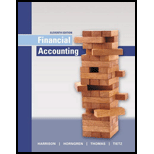
Financial Accounting (11th Edition)
11th Edition
ISBN: 9780134127620
Author: Walter T. Harrison Jr., Charles T. Horngren, C. William Thomas, Wendy M. Tietz
Publisher: PEARSON
expand_more
expand_more
format_list_bulleted
Question
Chapter 1, Problem 1.59AP
1.
To determine
To Prepare: Correct
2.
To determine
To Identify: Whether Incorporation S has a better financial position than Company E’s balance sheet report.
3.
To determine
To Identify: The accounts listed on the incorrect balance sheet that should not be reported on the balance sheet and explain the reason for excluding from the correct balance sheet and also identify where these accounts must appear in the financial statement.
Expert Solution & Answer
Want to see the full answer?
Check out a sample textbook solution
Students have asked these similar questions
Explain the concept of materiality in accounting. Need
What is the difference between a contra asset account and a liability? No ai
What is the difference between a contra asset account and a liability?
Chapter 1 Solutions
Financial Accounting (11th Edition)
Ch. 1 - Prob. 1QCCh. 1 - Prob. 2QCCh. 1 - Prob. 4QCCh. 1 - Prob. 5QCCh. 1 - Prob. 6QCCh. 1 - Prob. 7QCCh. 1 - Prob. 8QCCh. 1 - Prob. 9QCCh. 1 - Prob. 10QCCh. 1 - Prob. 11QC
Ch. 1 - Prob. 12QCCh. 1 - Prob. 13QCCh. 1 - Prob. 14QCCh. 1 - Prob. 1.1ECCh. 1 - Prob. 1.1SCh. 1 - Prob. 1.2SCh. 1 - LO 4 (Learning Objective 4: Identify income...Ch. 1 - Prob. 1.4SCh. 1 - (Learning Objective 2: Explain underlying...Ch. 1 - Prob. 1.6SCh. 1 - Prob. 1.7SCh. 1 - Prob. 1.8SCh. 1 - Prob. 1.9SCh. 1 - LO 4 (Learning Objective 4: Explain aspects of...Ch. 1 - Prob. 1.11SCh. 1 - Prob. 1.12SCh. 1 - Prob. 1.13SCh. 1 - Prob. 1.14SCh. 1 - Prob. 1.15SCh. 1 - Prob. 1.16SCh. 1 - Prob. 1.17SCh. 1 - Prob. 1.18SCh. 1 - Prob. 1.19AECh. 1 - Prob. 1.20AECh. 1 - Prob. 1.21AECh. 1 - Prob. 1.22AECh. 1 - Prob. 1.23AECh. 1 - Prob. 1.24AECh. 1 - Prob. 1.25AECh. 1 - Prob. 1.26AECh. 1 - Prob. 1.27AECh. 1 - Prob. 1.28AECh. 1 - Prob. 1.29AECh. 1 - Prob. 1.30AECh. 1 - Prob. 1.31BECh. 1 - Prob. 1.32BECh. 1 - Prob. 1.33BECh. 1 - Prob. 1.34BECh. 1 - Prob. 1.35BECh. 1 - Prob. 1.36BECh. 1 - Prob. 1.37BECh. 1 - Prob. 1.38BECh. 1 - Prob. 1.39BECh. 1 - Prob. 1.40BECh. 1 - Prob. 1.41BECh. 1 - Prob. 1.42BECh. 1 - Prob. 1.43QCh. 1 - Prob. 1.44QCh. 1 - Prob. 1.45QCh. 1 - Prob. 1.46QCh. 1 - Prob. 1.47QCh. 1 - Prob. 1.48QCh. 1 - Prob. 1.49QCh. 1 - Prob. 1.50QCh. 1 - Prob. 1.51QCh. 1 - Prob. 1.52QCh. 1 - Prob. 1.53QCh. 1 - Prob. 1.54QCh. 1 - Prob. 1.55QCh. 1 - Prob. 1.56QCh. 1 - Prob. 1.57QCh. 1 - Prob. 1.58APCh. 1 - Prob. 1.59APCh. 1 - Prob. 1.60APCh. 1 - Prob. 1.61APCh. 1 - Prob. 1.62APCh. 1 - Prob. 1.63APCh. 1 - Prob. 1.64BPCh. 1 - Prob. 1.65BPCh. 1 - Prob. 1.66BPCh. 1 - Prob. 1.67BPCh. 1 - Prob. 1.68BPCh. 1 - Prob. 1.69BPCh. 1 - Decision Cases LO 1, 4 (Learning Objectives 1, 4:...Ch. 1 - Prob. 2DCCh. 1 - Prob. 1EI
Knowledge Booster
Similar questions
- Joe transferred land worth $200,000, with a tax basis of $40,000, to JH Corporation, an existing entity, for 100 shares of its stock. JH Corporation has two other shareholders, Ethan and Young, each of whom holds 100 shares. With respect to the transfer:a. Joe has no recognized gain. b. JH Corporation has a basis of $160,000 in the land.c. Joe has a basis of $200,000 in his 100 shares in JH Corporation. d. Joe has a basis of $40,000 in his 100 shares in JH Corporation. e. None of the above.arrow_forwardI need help with this general accounting problem using proper accounting guidelines.arrow_forwardI am looking for the correct answer to this general accounting problem using valid accounting standards.arrow_forward
- accounting question?arrow_forwardThree individuals form JEY Corporation with the following contributions: Joe, cash of $50,000 for 50 shares; Ethan, land worth $20,000 (basis of $11,000) for 20 shares; and Young, cattle worth $9,000 (basis of $6,000) for 9 shares and services worth $21,000 for 21 shares. a. These transfers are fully taxable and not subject to § 351. b. Young’s basis in her stock is $27,000. c. Young’s basis in her stock is $6,000. d. Ethan’s basis in his stock is $20,000. e. None of the above.arrow_forwardNonearrow_forward
arrow_back_ios
SEE MORE QUESTIONS
arrow_forward_ios
Recommended textbooks for you

 AccountingAccountingISBN:9781337272094Author:WARREN, Carl S., Reeve, James M., Duchac, Jonathan E.Publisher:Cengage Learning,
AccountingAccountingISBN:9781337272094Author:WARREN, Carl S., Reeve, James M., Duchac, Jonathan E.Publisher:Cengage Learning, Accounting Information SystemsAccountingISBN:9781337619202Author:Hall, James A.Publisher:Cengage Learning,
Accounting Information SystemsAccountingISBN:9781337619202Author:Hall, James A.Publisher:Cengage Learning, Horngren's Cost Accounting: A Managerial Emphasis...AccountingISBN:9780134475585Author:Srikant M. Datar, Madhav V. RajanPublisher:PEARSON
Horngren's Cost Accounting: A Managerial Emphasis...AccountingISBN:9780134475585Author:Srikant M. Datar, Madhav V. RajanPublisher:PEARSON Intermediate AccountingAccountingISBN:9781259722660Author:J. David Spiceland, Mark W. Nelson, Wayne M ThomasPublisher:McGraw-Hill Education
Intermediate AccountingAccountingISBN:9781259722660Author:J. David Spiceland, Mark W. Nelson, Wayne M ThomasPublisher:McGraw-Hill Education Financial and Managerial AccountingAccountingISBN:9781259726705Author:John J Wild, Ken W. Shaw, Barbara Chiappetta Fundamental Accounting PrinciplesPublisher:McGraw-Hill Education
Financial and Managerial AccountingAccountingISBN:9781259726705Author:John J Wild, Ken W. Shaw, Barbara Chiappetta Fundamental Accounting PrinciplesPublisher:McGraw-Hill Education


Accounting
Accounting
ISBN:9781337272094
Author:WARREN, Carl S., Reeve, James M., Duchac, Jonathan E.
Publisher:Cengage Learning,

Accounting Information Systems
Accounting
ISBN:9781337619202
Author:Hall, James A.
Publisher:Cengage Learning,

Horngren's Cost Accounting: A Managerial Emphasis...
Accounting
ISBN:9780134475585
Author:Srikant M. Datar, Madhav V. Rajan
Publisher:PEARSON

Intermediate Accounting
Accounting
ISBN:9781259722660
Author:J. David Spiceland, Mark W. Nelson, Wayne M Thomas
Publisher:McGraw-Hill Education

Financial and Managerial Accounting
Accounting
ISBN:9781259726705
Author:John J Wild, Ken W. Shaw, Barbara Chiappetta Fundamental Accounting Principles
Publisher:McGraw-Hill Education